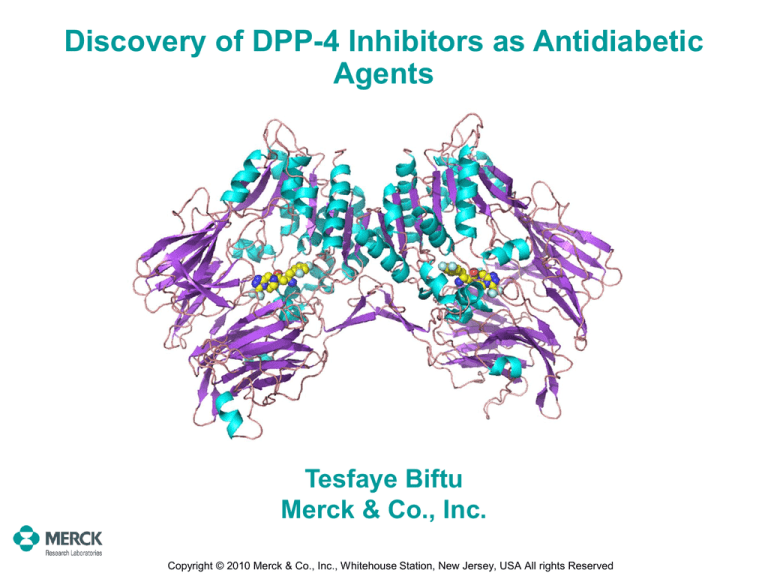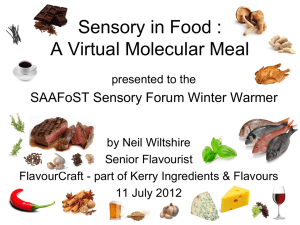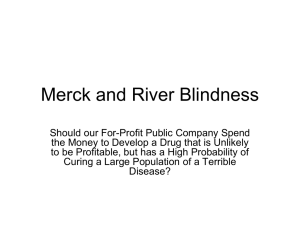
Discovery of DPP-4 Inhibitors as Antidiabetic
Agents
Tesfaye Biftu
Merck & Co., Inc.
Copyright © 2010 Merck & Co., Inc., Whitehouse Station, New Jersey, USA All rights Reserved
History of Diabetes
• c. 1552 B.C. – 1st reference to Rx for polyuria by HesyRa, 3rd Dynasty Ebers Papyrus
• c. 100 B.C. – The father of medicine in India, Susruta of
the Hindus, diagnosed diabetes
• c. 30 B.C. ~ 50 A.D. – 1st clinical description of diabetes,
Aulus Cornelius Celsus
• c. 150 A.D. – The name “diabetes” was first introduced
from the Greek word for “siphon” by Aretaeus of
Cappadocia
Copyright © 2010 Merck & Co., Inc., Whitehouse Station, New Jersey, USA All rights Reserved
……….continued
• Discovery of Insulin (1921) – An Instant Hit
– First Human Clinical Trial 1922
– Noble Price 1923 Benting & MacLoed
– Commercial Production 1923 Eli Lilly
– First Total Synthesis 1965 Chinese Team
• Discovery of Glucagon (1923) – Largely Unnoticed
– Sequenced in 1957
– Rediscovered in 1970’s for its role in diabetes
• Discovery of Incretins – Gastrointestinal Hormones
– 1932 The term “incretin” was first used
– 1970 GIP was isolated
– 1982 GLP-1 was sequenced
Copyright © 2010 Merck & Co., Inc., Whitehouse Station, New Jersey, USA All rights Reserved
Diabetes is a Growing Worldwide Epidemic
Europe
2000: 33.3 million
2030: 48 million
Middle East
2000: 15.2 million
2030: 42.6 million
The Americas
2000: 33 million
2030: 66.8 million
Africa
2000: 7 million
2030: 18.2 million
Asia and Australia
2000: 82.7 million
2030: 190.5 million
Prevalence (%) in
persons 35-64 yrs
<3 3-5 6-8 >8
•
•
2000: 171 million cases worldwide; 2030: 366 million cases predicted
>90% is Type 2 diabetes: obesity is a major risk factor
Copyright © 2010 Merck & Co., Inc., Whitehouse Station, New Jersey, USA All rights Reserved
WHO
Trends among U.S. Adults: 1994 to 2004
1994
<4%
4-4.9%
2004
5-5.9%
6+%
missing data
20,800,000 People in US (7%) have diabetes (2005)
6th Leading cause of death in US (2002), by death certificate
>90% Type 2, associated with metabolic syndrome
Taken from CDC diabetes website: http://www.cdc.gov/diabetes
Copyright © 2010 Merck & Co., Inc., Whitehouse Station, New Jersey, USA All rights Reserved
Current Medications for Treatment of Diabetes
Drug Class
Side Effects
Sulfonylureas
Hypoglycemia, weight gain
Meglitinides
Hypoglycemia, weight gain
Metformin
GI intolerance
Thiazolidinediones
Edema, weight gain
α-Glucosidase inhibitors
GI intolerance
Insulin
Hypoglycemia, weight gain
Safer and more effective medications are needed
Copyright © 2010 Merck & Co., Inc., Whitehouse Station, New Jersey, USA All rights Reserved
Role of Active GLP-1 and GIP in Glucose
Homeostasis
• Glucagon-Like-Peptide (GLP-1) and Glucose-DependentInsulotropic-Polypeptide (GIP) are secreted in response to
food intake (glucose-dependent mechanism)
• GLP-1 and GIP - (↑)stimulate insulin biosynthesis &
secretion
• GLP-1 inhibits - (↓) glucagon secretion
• GLP-1 and GIP - (↓)lower blood sugar level
Copyright © 2010 Merck & Co., Inc., Whitehouse Station, New Jersey, USA All rights Reserved
…. but Active GLP-1 (or GIP) is Cleaved
Rapidly by DPP-4
Stabilize GLP-1 (Active)
HA EGTFTSDVSSYLEGQAAKEFIAWLVKGR-NH2
Inhibit DPP-4
t½ ~ 1 min
GLP-1 (Inactive)
EGTFTSDVSSYLEGQAAKEFIAWLVKGR-NH2
Copyright © 2010 Merck & Co., Inc., Whitehouse Station, New Jersey, USA All rights Reserved
Dipeptidyl Peptidase IV (DPP-4)
• First Isolated from rat liver in 1966
• Identical to CD26, a marker for activated T cells
• Its role in energy homeostasis was discovered which led
to the first patent application in 1996
• Cell surface serine dipeptidase belonging to the prolyl
oligopeptidase family
• Widely expressed, and has Specificity for
P1 Pro >> Ala
Copyright © 2010 Merck & Co., Inc., Whitehouse Station, New Jersey, USA All rights Reserved
Selective Inhibitors
F
O
N
N
F
CF3
DPP-4 Selective
Enzyme
O
Me
N
NH2
N
N
Me
O
S N
O
NH2 O
N
NH2
S
I
QPP Selective
DPP-8/9 Selective
IC50, nM
DPP-9
> 100,000
11,000
55
DPP-8
69,000
22,000
38
> 100,000
> 100,000
> 100,000
27
1900
30,000
PEP
> 100,000
> 100,000
> 100,000
QPP/DPP-2
> 100,000
19
14,000
APP
> 100,000
> 100,000
> 100,000
prolidase
> 100,000
> 100,000
> 100,000
FAP
DPP-4
Copyright © 2010 Merck & Co., Inc., Whitehouse Station, New Jersey, USA All rights Reserved
Comparative Toxicity Study
2 wk. Rat Toxicity
QPP
Selective
DPP-8/9
Selective
Alopecia
Thrombocytopenia
Reticulocytopenia
DPP-4
Selective
Enlarged spleen
Mortality
Acute dog toxicity
Bloody diarrhea
G. Lankas, et al., Diabetes 2005, 54, 2988
Copyright © 2010 Merck & Co., Inc., Whitehouse Station, New Jersey, USA All rights Reserved
Potential Importance of Selective Inhibition for
the Treatment of Type 2 Diabetes
• Conclusion
– “Off-target” peptidase inhibition (i.e. inhibition of other DPP family
peptidases such as DPP8/9) can produce severe toxicity in
preclinical species
• Variables that may determine degree of toxicity
– Cell penetration
• Unlike DPP-4, DPP8/9 are intracellular
proteins
– Extent of inhibition of DPP8 and/or DPP9
• Not known if inhibition of both enzymes
(or how much) is required to produce
toxicities
– Intraspecies differences in DPP8/9 inhibition
DPP-4
from Demuth et al. Biochim.
Biophys. Acta 2005, 1751, 33
Copyright © 2010 Merck & Co., Inc., Whitehouse Station, New Jersey, USA All rights Reserved
DPP-4 Inhibitor Program - Objective
Identify a potent and selective DPP-4 inhibitor for the
treatment of type 2 diabetes mellitus with the following
characteristics:
• >1000-fold selectivity over other proline peptidases,
especially DPP-8 and DPP-9
• Half-life suitable for BID or preferably QD dosing
• Structure lacking reactive electrophile as a serine
trap, e.g.,
O
H2N
B(OH)2
N
R
R
O
H
N
CN
N
R'
X
Copyright © 2010 Merck & Co., Inc., Whitehouse Station, New Jersey, USA All rights Reserved
Common Lead Discovery Methods
• Biological screening of compounds
• Substrate or active-structure based design
• Enzyme – inhibitor crystal structure
Copyright © 2010 Merck & Co., Inc., Whitehouse Station, New Jersey, USA All rights Reserved
Screening Leads
Cl
• β-Amino acid proline amides
NH2 O
IC50 = 1.9 μM
O
H
N
O
O
N
N
H
• β-Amino piperazines
IC50 = 11 μM
H2N
N
O
N
N
H
Copyright © 2010 Merck & Co., Inc., Whitehouse Station, New Jersey, USA All rights Reserved
NHSO2Me
Recovery of Radioactivity after IV (1 mg/kg) or
Oral (2 mg/kg) Administration to Rats
T
NH 2
O
N
F
NH
Radioactivity Recovered in 24 hrs
(% Dose)
Collection Period Intravenous
Oral
Bile
28.3 ± 2.6%
38.2 ± 4.7%
Urine
18.1 ± 2.0%
14.0 ± 4.2%
Feces
1.0 ± 0.2%
1.4 ± 0.6%
Total
47.4 ± 3.9%
54.6 ± 4.9%
PK Rat:
• high clearance (>150 mL/min/kg) and
• short half-life.
Copyright © 2010 Merck & Co., Inc., Whitehouse Station, New Jersey, USA All rights Reserved
Y. Teffera
Metabolites identified in microsomes, hepatocites,
and bile of PO/IV treated rats
Microsomes: piperazine ring oxidation.
Hepatocytes: Conjugation of the primary amino group (glucuronic acid and
glucose). Oxidation of the piperazine, the phenyl and the fluoro-phenyl rings.
Glutathione conjugation on the fluoro-phenyl ring; d) amide bond hydrolysis.
Bile of PO treated rats: carbamoyl glucuronide conjugate on the piperazine ring.
Glutathione conjugation of the fluoro-phenyl ring, piperazine ring oxidation, and Nglucuronidation of the primary amine were also observed.
Bile of IV treated rats: Glutathione conjugation on the fluoro-phenyl ring,
piperazine and phenyl ring oxidation, and N-glucuronidation of the primary amine.
Urine of PO treated rats: Acid formed by the de-ethylation and oxidative deamination of the piperazine ring. Oxidation of the piperazine ring, glucuronidation
of the primary amine, and amide bond hydrolysis were also observed.
Urine of IV treated rats: excreted mainly parent compounds
Copyright © 2010 Merck & Co., Inc., Whitehouse Station, New Jersey, USA All rights Reserved
Efforts made to stabilize metabolism
NH2
O
NH2
O
N
F
N
X = NH, O
F
Copyright © 2010 Merck & Co., Inc., Whitehouse Station, New Jersey, USA All rights Reserved
N
Bicyclic Piperazine Replacements
N
N
N
N
N
N
S
R
N
N R'
O
N R
N
R
N
O
N
O
N
R
R
N
O
R
N
N
N
R
N
N
O
O
R"
R
N
R"
N
N
R'
N
N
R
N
N
N
R
R'
R
N
N R'
N
R"
N
N
S
N
R
N
R
R
N
N
N
N
N
R
N
N
N
R
N N
R
N
N
N
R
N
N
N
R'
R
N
N
N
R
N
N
N
N
N
N
R
R
N
R
N
R
N
Copyright © 2010 Merck & Co., Inc., Whitehouse Station, New Jersey, USA All rights Reserved
N
N
R
N
Left Hand Side SAR
NH2 O
R
N
N
N
N
CF3
Rat PK
R
DPP-4 IC50
(nM)
Clp
(mL/min/kg)
t½
(h)
Frat
(%)
3,4-diF
130
51
1.8
44
2,5-diF
27
43
1.6
50
60
1.7
76
2,4,5-triF
18
MK-0431 =
JANUVIA™ (sitagliptin phosphate)
100
D. Kim, et al., J. Med. Chem. 2005, 48, 141
Copyright © 2010 Merck & Co., Inc., Whitehouse Station, New Jersey, USA All rights Reserved
F
Sitagliptin: In Vitro Potency
and Selectivity
F
NH2 O
N
N
F
N
N
CF3
IC50, (nM)
Selectivity Ratio
DPP-9
> 100000
> 5000
DPP-8
48000
2700
> 100000
> 5000
DPP-4
18
1
DPP-6
not active
not active
PEP
> 100000
> 5000
QPP/DPP-2
> 100000
> 5000
APP
> 100000
> 5000
prolidase
> 100000
> 5000
FAP
DPP-4
Gene
Family
Other Proline
Specific
Enzymes
Copyright © 2010 Merck & Co., Inc., Whitehouse Station, New Jersey, USA All rights Reserved
F
PK Properties of Sitagliptin
1 mg/kg IV, 2 mg/kg PO
F
NH2 O
N
N
F
N
N
CF3
species
M
o
u
R
a
D
M
o
s
t
o
n
e
Clp
(mL/min/kg)
y
PO AUCnorm
(μM·h/mpk)
PO Cmax
μ
(
M
F
)
(
%
)
4
3
.
8
0
.
8
0
.
4
1
0
.
5
1
6
1
6
0
6
.
4
1
.
7
0
.
5
2
0
.
3
3
7
6
9
.
0
4
.
9
8
.
3
2
.
3
3
.
7
1
.
0
6
e
t½
(h)
6
g
k
Vd
(mL/kg)
2
8
.
0
2
0
.
.
3
Copyright © 2010 Merck & Co., Inc., Whitehouse Station, New Jersey, USA All rights Reserved
2
1
3
0
6
0
8
Pharmacodynamics of Sitagliptin: OGTT in Lean Mice
20 min post Glucose, 80 min post Compound
100
Glucose AUC
80
60
40
20
0
0
0.1
0.3
1
3
Plasma DP-IV % inhibition
(uncorrected)
Glucose AUC, % vehicle
100
80
DPP-4
DPP-4 Inhibition
Inhibition
(uncorrected)
60
40
20
0
0
0.1
0.3
1
Sitagliptin,
mg/kg
L-224715, mg/kg
Sitagliptin,
mg/kg
L-224715, mg/kg
Plasma [GLP-1]
intact
, pM
8
Active GLP-1
6
4
2
0
0
0.1
0.3
1
L-224715, mg/kg
Sitagliptin,
mg/kg
3
Dose, mg/kg
[sitagliptin], nM
0.1
19
0.3
52
1
190
3
600
Mouse DPP-4: IC50 = 69 nM
Copyright © 2010 Merck & Co., Inc., Whitehouse Station, New Jersey, USA All rights Reserved
3
Chronic Efficacy with a Sitagliptin Analog in Mice
Restoration of Pancreatic Islet Cells
Islets from HFD/STZ mice +/- 10 weeks of treatment with sitagliptin analog
Diabetic Mice
Diabetic Mice + Sitagliptin analog
Lean Control Mice
Green: Insulin-producing cell
Red: Glucagon-producing α cell
Copyright © 2010 Merck & Co., Inc., Whitehouse Station, New Jersey, USA All rights Reserved
JANUVIATM
F
F
NH2 O
(sitagliptin)
Launched, Oct. 2006
N
N
F
H3PO4
H2O
N
N
CF3
• Selective inhibition of DPP-4, in particular with respect to DPP-8 and/or
DPP-9, provides an improved safety profile in preclinical species.
• Sitagliptin is a potent and selective DPP-4 inhibitor, very well tolerated in
pre-clinical toxicity studies and in human clinical trials.
• In patients with type 2 diabetes, once daily administration of sitagliptin
stabilizes active GLP-1 and GIP, reduces glucose excursion, enhances
insulin levels, suppresses glucagon levels, and improves glycemic
control.
• JANUVIA™ (sitagliptin) was approved by the FDA as a new treatment for
type 2 diabetes.
For more info: www.januvia.com
Copyright © 2010 Merck & Co., Inc., Whitehouse Station, New Jersey, USA All rights Reserved
Back-up Objective
Identify a specific DPP-4 inhibitor as a back-up
to sitagliptin
• Potency equivalent to or better than sitagliptin
• Increased half-life suitable for QD dosing
• Structural diversity
Copyright © 2010 Merck & Co., Inc., Whitehouse Station, New Jersey, USA All rights Reserved
α-Amino Acid Series Revisited
• Allo isomer is ~10-fold more toxic than threo
• Incorporate “threo” bias into α-amino acid
series?
Me
O
Me
Me
Me
N
NH2
S
threo Ile-thiazolidide
Enzyme
DPP-4
QPP
DPP-8
DPP-9
O
N
NH2
S
allo Ile-thiazoldide
IC50 (nM)
IC50 (nM)
440
14,000
2,200
1,600
460
18,000
220
320
Copyright © 2010 Merck & Co., Inc., Whitehouse Station, New Jersey, USA All rights Reserved
β-Substituted Phenylalanine Derivatives
Me
Me
O
Me
O
N
N
NH2
NH2
S
F
F
Enzyme
IC50 (nM)
Enzyme
DPP-4
QPP
DPP-8
DPP-9
420
14,000
2,200
1,600
DPP-4
QPP
DPP-8
DPP-9
IC50 (nM)
64
2,700
88,000
86,000
Rat PK
Clp
t1/2 (h)
F (%)
8.6
2.2
85
hERG IC50 = 1.1 µM
J. Xu et al. Bioorg. Chem. Med. Lett. 2005, 15, 2533;
S. D. Edmondson et al., J. Med. Chem. 2006, 49, 3614
Copyright © 2010 Merck & Co., Inc., Whitehouse Station, New Jersey, USA All rights Reserved
β-Substituted Phenylalanine Derivatives
Me
Me
O
O
N
Me
N
NH2
NH2
S
F
F
Enzyme
IC50 (nM)
Enzyme
DPP-4
QPP
DPP-8
DPP-9
420
14,000
2,200
1,600
DPP-4
QPP
DPP-8
DPP-9
IC50 (nM)
64
2,700
88,000
86,000
Rat PK
Clp
t1/2 (h)
F (%)
8.6
2.2
85
• Optimization Goals
– Increase potency
and selectivity
– Decrease ion
channel binding
– Maintain good oral
bioavailability
hERG IC50 = 1.1 µM
Copyright © 2010 Merck & Co., Inc., Whitehouse Station, New Jersey, USA All rights Reserved
β-Substituted Phenylalanine Derivatives
Me
Me
O
Me
O
N
Me
N
NH2
Me
N
O
O
NH2
S
N
F
F
NH2
N N
F
N
Enzyme
IC50 (nM)
Enzyme
DPP-4
QPP
DPP-8
DPP-9
420
14,000
2,200
1,600
DPP-4
QPP
DPP-8
DPP-9
IC50 (nM)
64
2,700
88,000
86,000
Rat PK
Clp
t1/2 (h)
F (%)
8.6
2.2
85
hERG IC50 = 1.1 µM
F
Enzyme
IC50 (nM)
DPP-4
QPP
DPP-8
DPP-9
8.8
~100,000
>100,000
>100,000
Rat PK
Clp
t1/2 (h)
F (%)
2.8
1.6
100
hERG IC50 = >100 µM
Copyright © 2010 Merck & Co., Inc., Whitehouse Station, New Jersey, USA All rights Reserved
Me
α-Amino Amide Back Up
Me
N
O
O
N
N N
• Criteria
NH2
N
Potency equivalent to or better than sitagliptin
– Increased t1/2
Potential for balanced renal/hepatic clearance
Structural diversity
• Potential Liabilities
– Modest QTc prolongation in CV dog
• Strategy
– Position as an insurance back-up, should unexpected safety
issues arise with sitagliptin
– Bulk drug prepared for 14-wk safety studies
Identify an additional back up compound lacking QTc liability
Copyright © 2010 Merck & Co., Inc., Whitehouse Station, New Jersey, USA All rights Reserved
F
F
Active-Structure Based Design
• Sitagliptin is a triazolopyrazine
F
F
NH2 O
N
N
F
N
N
CF3
• Triazolopyrazines are reported as bioisosters of amides
O
TL, 41, (2000) 4533
N
N
N
& Ann Rep Med Chem
N
N
O
Copyright © 2010 Merck & Co., Inc., Whitehouse Station, New Jersey, USA All rights Reserved
Design
F
F
NH2 O
R
NH2 O
N
N
F
O
N
N
N
R
F
NH
CF3
R = H, IC50 = 140 nM
R = Me, IC50 = 89 nM
R = H, IC50 = 27 nM
R = Me, IC50 = 7.2 nM
R
DPP-4
IC50, nM
R
N
O
O
N
N
N
N
N
160
R
O
89
14
R = Di-Fluoro phenyl β-AA series
Copyright © 2010 Merck & Co., Inc., Whitehouse Station, New Jersey, USA All rights Reserved
Activity vs. Stereochemistry
F
F
F
F
NH2 O
NH
F
F
DPP-4 IC50 = 140 nM
F
F
(R)
NH
F
DPP-4 IC50 = 403 nM
O
N *
(R)
NH
(S)
O
N *
NH
F
DPP-4 IC50 = 150nM
F
F
F
NH2 O
O
N
NH2 O
(R)
DPP-4 IC50 = 6.6 nM
F
NH2 O
F
NH2 O
O
N
(R)
F
F
(S)
NH2 O
(R)
N
O
NH
DPP-4 IC50 = 67,000 nM
F
(S)
(S)
N
O
NH
DPP-4 IC50 = 2,300 nM
Activity: R,R > R,S > S,S > S,R
Copyright © 2010 Merck & Co., Inc., Whitehouse Station, New Jersey, USA All rights Reserved
a-Substituted Aryl Diazepanone Derivatives
R
DPP-4
(nM)
H
0.91
QPP
(nM)
17,000
DPP8
(nM)
R
F
F
NH2 O
21,000
2-Me
0.26
7,600
21,000
2-F
0.33
21,000
25,000
2-CF3
0.35
5,100
36,000
[2-Pyridine]
0.49
89,000
53,000
[2-Pyrrazole]
0.29
75,000
80,000
O
N
F
Copyright © 2010 Merck & Co., Inc., Whitehouse Station, New Jersey, USA All rights Reserved
NH
a-Alkylation of Diazepanone Derivatives
R
H
DPP-4 (nM)
140
QPP (nM)
>100,000
DPP8 (nM)
F
F
Et
CH2CF3
iBu*
CH2(cPr)
6.6
16
2.6
25
4.8
59,000
46,000
47,000
13,000
59,000
28,000
35,000
79,000
27,000
11,000
O
N
82,000
F
Me
R
NH2 O
* N-methyl diazepanone
Copyright © 2010 Merck & Co., Inc., Whitehouse Station, New Jersey, USA All rights Reserved
NH
N-Alkylation of Diazepanone Derivatives
R
DPP-4
(nM)
QPP
(nM)
DPP8 (nM)
F
F
H
6.6
59,000
NH2 O
46,000
N
F
Me
6.6
>100,000
21,000
CH2CH2OH
16
78,000
53,000
CH2CF3
19
56,000
43,000
iPr
44
18,000
>100,000
cPr
8
46,000
22,000
O
Copyright © 2010 Merck & Co., Inc., Whitehouse Station, New Jersey, USA All rights Reserved
N R
5,6 or 7-Alkylated Diazepanone Derivatives
R
DPP-4 (nM)
QPP (nM)
DPP8 (nM)
F
F
5α-Me/5β-Me
6α-Me/6β-Me
6,6-di Me
7α –Me/7β-Me
NH2 O
765/1050
N
F
13/33
140
15/400
O
56,000
70,000
17,000
26,000
73,000
79,000
7-CF3
140
>100,000
76,000
7-(2-F-Bn)
130
8,700
19,000
Copyright © 2010 Merck & Co., Inc., Whitehouse Station, New Jersey, USA All rights Reserved
NH
5
6
7
Phenyl Substituents
CF3
NH2 O
N
R
R
2-F
O
NH
DPP-4 (nM)
84
QPP (nM)
DPP8 (nM)
>100,000
27,000
2,5-Di F
7.4
>100,000
22,000
2,4,5-Tri F
2.6
59,000
28,000
Copyright © 2010 Merck & Co., Inc., Whitehouse Station, New Jersey, USA All rights Reserved
SAR Summary
R-isomer more potent than S-isomer
Substituted benzyl/aryl most potent
R = 2,4,5 tri-F
Best potency and PK
R
NH2 O
R
N
O
N R'
Less potent
Short half-life
Loss of potency
Not promising
Less potent
α isomer more
potent than β
Less potent,
Good selectivity
Improved PK
α isomer more
potent than β
Copyright © 2010 Merck & Co., Inc., Whitehouse Station, New Jersey, USA All rights Reserved
Pharmacokinetics…
Rat PK
O
Clp
(mL/min/kg)
T1/2
(h)
Foral
(%)
nAUC
(mM h/mpk)
88
1
41%
0.18
94
2
94%
0.16
93
4.3
45%
0.39
51
1.5
49%
0.25
O
N
NH
CF3
O
O
N
O
NH
O
N
O
N
O
N
NH
*PK parameters were obtained following a iv (1 mg/kg) or po (2 mg/kg) dose
Copyright © 2010 Merck & Co., Inc., Whitehouse Station, New Jersey, USA All rights Reserved
Trifluroethyl Diazepanone Candidate
Potency and selectivity:
IC50 (nM)
BU
DPP-4
QPP
DPP8
DPP9
PEP
APP
Prolidase
FAP
2.6
59,000
28,000
41,000
>100,000
>100,000
>100,000
23,000
F
F
NH2 O
O
N
F
NH
• Pharma services >10,000 nM
Off-target Activity:
IC50 (nM)
except Ca channel (Ki=5.5 μM)
BU
IKr
Ca
Na
CF3
>90,000
11,000
~50,000
Copyright © 2010 Merck & Co., Inc., Whitehouse Station, New Jersey, USA All rights Reserved
Oral Bioavailability
Species
Prot.Binding
Clp
(% bound) (mL/min/kg)
Vd
(L/kg)
t½
(h)
PO AUCnorm
(μM·h/mpk)
PO Cmax
(μM)
F
(%)
Rat
89
94
12
1.9
0.157
0.085
36
Dog
91
18
11
8.9
2.19
0.522
95
Rhesus
90
53
18
5.4
0.15
0.162
20**
Human
91
[6-23]*
* Estimated
** Low %F due to first pass effect
Copyright © 2010 Merck & Co., Inc., Whitehouse Station, New Jersey, USA All rights Reserved
Stability in Liver Microsomes and Hepatocytes
Liver Microsomes
at 1 mM, 1 mg/mL protein
Hepatocytes
at 1 mM, 1 M cells/mL
100.0
% Parent Remaining
% Parent Remaining
100.0
80.0
60.0
RLM
DLM
MLM
HLM
40.0
20.0
0.0
80.0
60.0
RLM
DLM
MLM
HLM
40.0
20.0
0.0
0
10
20
30
40
Time (min)
50
60
70
0
20
40
60
80
Time (min)
Copyright © 2010 Merck & Co., Inc., Whitehouse Station, New Jersey, USA All rights Reserved
100
120
Pharmacodynamics…
Glucose AUC
100
80
60
40
20
0
0
0.1
0.3
1
Dose, mg/kg
L-001169872,
mg/kg
3
100
Plasma DP-IV % inhibition
(uncorrected)
Glucose AUC, % vehicle
Lean Mice, 0 min post Glucose, 70 min post Compound
80
DP-IV inhibition
(uncorrected)
60
40
20
0
0
0.1
0.3
1
Dose, mg/kg
L-001169872,
mg/kg
3
Plasma [GLP-1]
intact
, pM
12
Active GLP-1
Dose, mg/kg
Plasma Level, nM
8
0.1
7.5
6
0.3
24.8
4
1
84.2
2
3
266
10
0
0
0.1
0.3
1
Dose, mg/kgmg/kg
L-001169872,
3
Mouse DP-IV: IC50 = 26.8 nM
Copyright © 2010 Merck & Co., Inc., Whitehouse Station, New Jersey, USA All rights Reserved
Summary Results
•
•
•
•
•
•
•
Structurally diverse – unique right hand side
Potent
Selective
Efficacious in OGTT model
Excellent PK profile
Metabolically stable in human microsome preparation
14 weeks rat and dog safety OK
Kept on hold as an insurance back-up to sitagliptin
Copyright © 2010 Merck & Co., Inc., Whitehouse Station, New Jersey, USA All rights Reserved
Most Common Lead Discovery Methods
• Biological screening of compounds
• Substrate or active-structure based design
• Enzyme – inhibitor crystal structure
Crystal structure of DPP-4 reported in 2002
Copyright © 2010 Merck & Co., Inc., Whitehouse Station, New Jersey, USA All rights Reserved
Structure of DPP-4 Complex with val-pyr and
Sitagliptin
NH2
Me
N
Me
O
Val-pyr
IC50 = 1600 nM
F
F
NH2
O
N
N
F
N
N
CF3
Sitagliptin
IC50 = 18 nM
Copyright © 2010 Merck & Co., Inc., Whitehouse Station, New Jersey, USA All rights Reserved
Computer Modeling
H-Bonding
H-Bonding
Salt Bridge
Salt Bridge
F
O
NH2
O
N
N
N
F
NH2
N
N
F
F3C
IC50 = 4.4 nM
Copyright © 2010 Merck & Co., Inc., Whitehouse Station, New Jersey, USA All rights Reserved
Computer Modeling
Plenty of
Room
No Room!!
The Same
Salt Bridge
H-Bonding Salt Bridge
F
F
O
N
N
F
NH2
F
NH2
O
N
N
N
N
New
H-Bonds
F
F
N
N
CF3
F3C
IC50 = 0.6 nM
Rotate
Copyright © 2010 Merck & Co., Inc., Whitehouse Station, New Jersey, USA All rights Reserved
Rigid Analogs:
A New Generation of DPP-4 Inhibitors
F
H2N
F
O
N
F
F
F
A
NH2
A
B
C
O
Best Fit
N
F
B
F
H2N
F
C
N
F
Copyright © 2010 Merck & Co., Inc., Whitehouse Station, New Jersey, USA All rights Reserved
Sitagliptin and Cyclohexylamine in the DPP-4
Active Site
F
R125
F
NH2
O
S209
N710
N
N
E205
N
N
F
CF3
Sitagliptin
IC50 = 18 nM
E206
F
F
R358
NH2
F
Y666
Y547
N
N
N
F357
Copyright © 2010 Merck & Co., Inc., Whitehouse Station, New Jersey, USA All rights Reserved
N
CF3
Phenyl Substituents
NH2
CF3
R
H
O
O
N
NH
Tri-F pheny results in better H-bond and enhances potency
R
DPP-4 (nM)
2-F
84
QPP (nM)
DPP8 (nM)
IKr (nM)
>100,000
27,000
-
2,5-Di F
7.4
>100,000
22,000
63,000
2,4,5-Tri F
2.6
59,000
28,000
90,000
Copyright © 2010 Merck & Co., Inc., Whitehouse Station, New Jersey, USA All rights Reserved
Cyclohexylamine DPP-4 Inhibitor
F
F
Enzyme
DPP-4
QPP
DPP-8
DPP-9
IKr
Ca
Na
NH2
F
N
N
N
N
CF3
Species
Clp
(mL/min/kg)
t½
(h)
Rat
Dog
Rhesus
7.6
3.9
9.5
6.6
18
14
PO AUCnorm
(μM·h/mpk)
6.8
10.1
3.9
IC50 (nM)
21
>100,000
>100,000
>100,000
40,000
12,000
>50,000
PO Cmax
(μM)
F
(%)
0.14
0.93
0.56
130
95
94
OGTT – maximum efficacious dose 1 mpk
Copyright © 2010 Merck & Co., Inc., Whitehouse Station, New Jersey, USA All rights Reserved
5,6-Heterocycles: A Better Fit?
F
F
NH2
F
N
N
N
N
CF3
IC50 = 21 nM
?
F
F
NH2
F
N
CF3
Copyright © 2010 Merck & Co., Inc., Whitehouse Station, New Jersey, USA All rights Reserved
Cyclohexylamine Derivatives
F
F
• Increasing selectivity:
NH2
3D QSAR Model
F
N
R
R
DPP-4
(nM)
QPP
(nM)
DPP-8
(nM)
H
6.6
67,000
1700
CF3
7.6
88,000
5800
H-bond acceptor
H-bond donor
heteroatoms and/or
polar groups preferred
Y. Gao, et al., Bioorg. Med. Chem. Lett. 2007, 17, 3877
Copyright © 2010 Merck & Co., Inc., Whitehouse Station, New Jersey, USA All rights Reserved
Cyclohexylamine Derivatives
F
F
F
F
NH2
F
NH2
F
N
N
N
R
R
N
R
DPP-4
(nM)
QPP
(nM)
DPP-8
(nM)
R
DPP-4
(nM)
QPP
(nM)
DPP-8
(nM)
H
6.6
67,000
1700
H
0.67
>100,000
5000
CF3
7.6
88,000
5800
CF3
0.53
>100,000
4600
Y. Gao, et al., Bioorg. Med. Chem. Lett. 2007, 17, 3877
Copyright © 2010 Merck & Co., Inc., Whitehouse Station, New Jersey, USA All rights Reserved
Cyclohexylamine Derivatives
F
• RF = H
NH2 Clp, low %F)
– Poor PK (high
– hERG IC50 = 37 µm
F
• R = CF3
N
N
– Good PK properties
– hERG IC50 = 4.8 µM N
– QTc in CV dog
R
R
DPP-4
(nM)
QPP
(nM)
DPP-8
(nM)
H
0.67
>100,000
5000
CF3
0.53
>100,000
4600
Y. Gao, et al., Bioorg. Med. Chem. Lett. 2007, 17, 3877
Copyright © 2010 Merck & Co., Inc., Whitehouse Station, New Jersey, USA All rights Reserved
F
F
NH2
N-Aryl Piperidines
F
N
Ar
Compound
Ar
Cav1.2
(nM)
Cyp2D6
(nM)
t1/2
(h)
F
(%)
37
>59,000
27,000
950
0.46
98
31
>10,000
240
1,700
1.2
32
5.3
>100,000
960
110
4.9
87
1.9
>56,000
88
4,400
1.6
37
N
N
L-001346262
L-001464016
DPP8/9
(nM)
N
L-001331552
L-001427229
DPP-4
(nM)
N N
N
N N
CF3
N
N
Me
N
N
Compounds with increased selectivity have poor PK
Copyright © 2010 Merck & Co., Inc., Whitehouse Station, New Jersey, USA All rights Reserved
Fused Imidazopyridines
F
F
NH2
F
N
N
N
N
N
N
Target
IC50 (nM)
IC50 (nM)
DPP-4
330
51
23,000
>100,000
>100,000
19,000
DPP-8
>100,000
72,000
>100,000
>100,000
DPP-9
>100,000
8,400
>100,000
>100,000
QPP
IC50 (nM)
8.3
IC50 (nM)
15
Cav1.2
n.d.
>100,000
>100,000
>100,000
Cyp2D6
n.d.
19,000
13,000
5,200
Copyright © 2010 Merck & Co., Inc., Whitehouse Station, New Jersey, USA All rights Reserved
F
F
NH2
New Scaffold
F
N
N
N
• Potent, selective DPP-4
inhibitor
• Novel structure, distinct
from other development
candidates
• Multiple routes of
clearance
• Human PK projections
suggest QD dosing
Copyright © 2010 Merck & Co., Inc., Whitehouse Station, New Jersey, USA All rights Reserved
Summary
• Structurally diverse middle ring designed by
collaboration between MedChem, Structural biology and
modeling groups
• Potent
• Selective
• Efficacious in OGTT model
• Excellent PK profile
Promising novel lead for development of
a new generation of DPP-4 inhibitors
Copyright © 2010 Merck & Co., Inc., Whitehouse Station, New Jersey, USA All rights Reserved
Acknowledgements
Medicinal Chemistry
Wally Ashton
Tes Biftu
Linda Brockunier
Chuck Caldwell
Ping Chen
Hong Dong
Scott Edmondson
Dennis Feng
Mike Fisher
Ed Gonzalez
Jiafang He
Dooseop Kim
Gui-Bai Liang
Tony Mastracchio
Bob Mathvink
Hyun Ok
You Jung Park
Emma Parmee
Xiaoxia Qian
Leah Reigle
Rosemary Sisco
Liping Wang
Lan Wei
Ann Weber
Matt Wyvratt
Jinyou Xu
Metabolic Disorders
Savita Jagpal
Joanne Jiang
David Kuo
Barbara Leiting
Zhihua Li
Frank Marsilio
David Moller
Reshma Patel
Kelly Ann Pryor
Ranabir Sinha Roy
Nancy Thornberry
Kenny Wong
Joe Wu
Bei Zhang
Lan Zhu
BCAS
Larry Colwell
Huaibing He
Dorothy Levorse
Kathy Lyons
Karen Owens
X-Ray & Modeling
Giovanna Scapin
Sangita Patel
Suresh Singh
Ying-duo Gao
Drug Metabolism
Maria Beconi
Adria Colletti
Varsha Didolkar
David Evans
Chris Kochansky
Sanjeev Kumar
David Liu
Tony Pereira
Ralph Stearns
Yohannes Teffera
Regina Wang
Sherrie Xu
Wenji Yin
Immunology/Rheumatology
Jerry Di Salvo
Ruth Kilburn
Greg Koch
Elizabeth Nichols
Eugene O’Neill
Linda Wicker
Synthetic Service
Phil Eskola
Mark Levorse
Bob Frankshun
Amanda
Makarewicz
In Vivo Pharmacology
Ed Brady
George Eiermann
Judy Gorski
Gerry Hickey
Peggy McCann
Joe Metzger
Alex Petrov
Dick Saperstein
Alison Strack
Comparative Medicine
Irene Capodanno
Paul Cunningham
Marcie Donnelly
William Feeney
Judy Fenyk-Melody
James Hausamann
Donald Hora
Christian Nunes
Allison Parlapiano
Gina Seeburger
Xiaolan Shen
John Strauss
Kenneth Valerich
Zuliang Yao
Copyright © 2010 Merck & Co., Inc., Whitehouse Station, New Jersey, USA All rights Reserved








